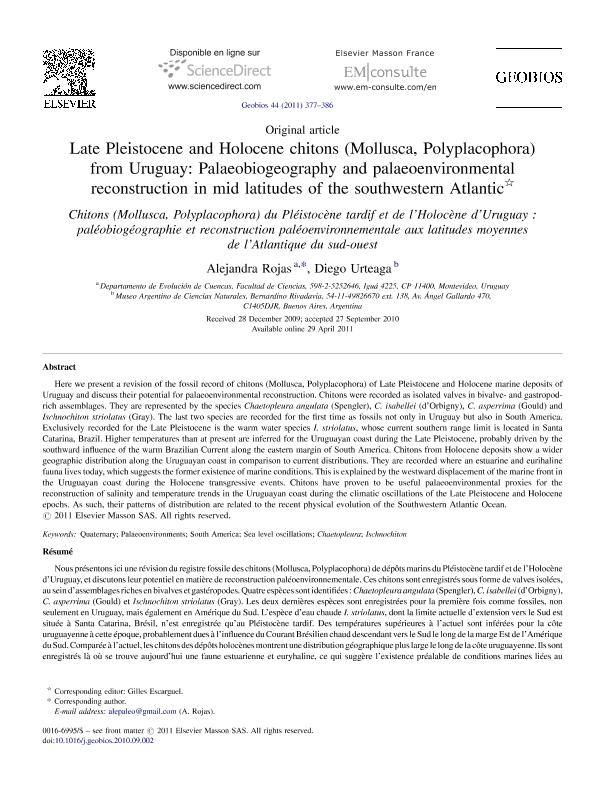Mostrar el registro sencillo del ítem
dc.contributor.author
Rojas, A.
dc.contributor.author
Urteaga, Diego Gaston

dc.date.available
2019-01-30T17:05:46Z
dc.date.issued
2011-07
dc.identifier.citation
Rojas, A.; Urteaga, Diego Gaston; Late Pleistocene and Holocene chitons (Mollusca, Polyplacophora) from Uruguay: Palaeobiogeography and palaeoenvironmental reconstruction in mid latitudes of the southwestern Atlantic; Elsevier Masson; Geobios; 44; 4; 7-2011; 377-386
dc.identifier.issn
0016-6995
dc.identifier.uri
http://hdl.handle.net/11336/68998
dc.description.abstract
Here we present a revision of the fossil record of chitons (Mollusca, Polyplacophora) of Late Pleistocene and Holocene marine deposits of Uruguay and discuss their potential for palaeoenvironmental reconstruction. Chitons were recorded as isolated valves in bivalve- and gastropod-rich assemblages. They are represented by the species Chaetopleura angulata (Spengler), C. isabellei (d'Orbigny), C. asperrima (Gould) and Ischnochiton striolatus (Gray). The last two species are recorded for the first time as fossils not only in Uruguay but also in South America. Exclusively recorded for the Late Pleistocene is the warm water species I. striolatus, whose current southern range limit is located in Santa Catarina, Brazil. Higher temperatures than at present are inferred for the Uruguayan coast during the Late Pleistocene, probably driven by the southward influence of the warm Brazilian Current along the eastern margin of South America. Chitons from Holocene deposits show a wider geographic distribution along the Uruguayan coast in comparison to current distributions. They are recorded where an estuarine and eurihaline fauna lives today, which suggests the former existence of marine conditions. This is explained by the westward displacement of the marine front in the Uruguayan coast during the Holocene transgressive events. Chitons have proven to be useful palaeoenvironmental proxies for the reconstruction of salinity and temperature trends in the Uruguayan coast during the climatic oscillations of the Late Pleistocene and Holocene epochs. As such, their patterns of distribution are related to the recent physical evolution of the Southwestern Atlantic Ocean.
dc.format
application/pdf
dc.language.iso
eng
dc.publisher
Elsevier Masson

dc.rights
info:eu-repo/semantics/openAccess
dc.rights.uri
https://creativecommons.org/licenses/by-nc-nd/2.5/ar/
dc.subject
Chaetopleura
dc.subject
Ischnochiton
dc.subject
Palaeoenvironments
dc.subject
Quaternary
dc.subject
Sea Level Oscillations
dc.subject
South America
dc.subject.classification
Paleontología

dc.subject.classification
Ciencias de la Tierra y relacionadas con el Medio Ambiente

dc.subject.classification
CIENCIAS NATURALES Y EXACTAS

dc.subject.classification
Otras Ciencias Biológicas

dc.subject.classification
Ciencias Biológicas

dc.subject.classification
CIENCIAS NATURALES Y EXACTAS

dc.title
Late Pleistocene and Holocene chitons (Mollusca, Polyplacophora) from Uruguay: Palaeobiogeography and palaeoenvironmental reconstruction in mid latitudes of the southwestern Atlantic
dc.type
info:eu-repo/semantics/article
dc.type
info:ar-repo/semantics/artículo
dc.type
info:eu-repo/semantics/publishedVersion
dc.date.updated
2019-01-30T13:59:19Z
dc.journal.volume
44
dc.journal.number
4
dc.journal.pagination
377-386
dc.journal.pais
Francia

dc.description.fil
Fil: Rojas, A.. Universidad de la República. Facultad de Ciencias; Uruguay
dc.description.fil
Fil: Urteaga, Diego Gaston. Consejo Nacional de Investigaciones Científicas y Técnicas. Oficina de Coordinación Administrativa Parque Centenario. Museo Argentino de Ciencias Naturales “Bernardino Rivadavia”; Argentina
dc.journal.title
Geobios

dc.relation.alternativeid
info:eu-repo/semantics/altIdentifier/doi/http://dx.doi.org/10.1016/j.geobios.2010.09.002
dc.relation.alternativeid
info:eu-repo/semantics/altIdentifier/url/https://www.sciencedirect.com/science/article/pii/S0016699511000313
Archivos asociados
